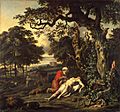Parable facts for kids
A parable is a short story that teaches a lesson. It's like a riddle or a puzzle that helps you understand a bigger idea. Often, parables use simple situations, like stories about animals, everyday objects, or people, to explain something important about life, morals, or beliefs. They don't always tell you the lesson directly; instead, they let you figure it out yourself.
Two famous examples of parables come from Jesus and Aesop. Jesus used parables to explain his teachings, like the story of the Good Samaritan. Aesop, an ancient Greek storyteller, is known for his fables, which are a type of parable, often featuring talking animals that teach a moral lesson.
Contents
What Is a Parable?
A parable is a special kind of story. It's usually short and easy to understand. The main goal of a parable is to teach a moral, spiritual, or practical lesson. Think of it as a clever way to share wisdom.
How Parables Work
Parables use something called a metaphor. A metaphor is when you describe one thing by saying it is another. For example, if a parable is about a farmer planting seeds, the seeds might not just be seeds. They could represent ideas, words, or opportunities. The story helps you connect the simple tale to a deeper meaning.
Parables vs. Fables
Sometimes, people confuse parables with fables. They are very similar!
- A parable usually teaches a spiritual or moral lesson. The characters are often humans, and the stories feel realistic, even if they have a hidden meaning.
- A fable often uses animals or inanimate objects that talk and act like humans. Fables almost always end with a clear moral statement, like "Slow and steady wins the race."
Both parables and fables are great ways to share important ideas in a memorable way.
Famous Parables and Their Lessons
Many cultures and religions use parables to pass down wisdom. They are powerful because they are easy to remember and make you think.
Parables from the Bible
The Bible contains many parables told by Jesus. These stories helped people understand complex ideas about faith, kindness, and how to live.
The Good Samaritan
One well-known parable is about the Good Samaritan. In this story, a man is robbed and left hurt on the side of the road. Several people pass by without helping him. Finally, a Samaritan, who was from a group often disliked by the people listening to Jesus, stops to help the injured man. He takes care of him and pays for his recovery.
- Lesson: This parable teaches us to show kindness and compassion to everyone, even those we might not expect to help, or those who are different from us. It shows that true neighborliness means helping anyone in need.
The Prodigal Son
Another famous parable is The Prodigal Son. It tells of a son who leaves home, wastes all his money, and then returns. His father welcomes him back with open arms, even though the older brother is upset.
- Lesson: This story teaches about forgiveness, unconditional love, and second chances. It shows that it's never too late to come back and that love can overcome mistakes.
Aesop's Fables
Aesop is famous for his short fables, which are like parables. They often feature animals and end with a clear moral.
The Tortoise and the Hare
In this fable, a speedy hare challenges a slow tortoise to a race. The hare is so confident he'll win that he takes a nap during the race. The tortoise, moving slowly but steadily, eventually crosses the finish line first.
- Lesson: This fable teaches that "slow and steady wins the race." It means that being consistent and persistent is often more important than being fast or flashy.
The Boy Who Cried Wolf
This story is about a shepherd boy who repeatedly tricks villagers by shouting that a wolf is attacking his sheep, even when there isn't one. When a real wolf finally appears, the villagers don't believe him, and his sheep are eaten.
- Lesson: The moral is that if you lie often, people won't believe you even when you tell the truth. It teaches the importance of honesty.
Why Are Parables Important?
Parables have been used for thousands of years because they are a very effective way to teach.
Easy to Remember
Stories are much easier to remember than a list of rules or abstract ideas. When you hear a parable, the characters and events stick in your mind, making the lesson memorable.
Encourage Thinking
Parables don't just tell you what to think; they make you think for yourself. By figuring out the hidden meaning, you understand the lesson more deeply. This makes the lesson more personal and powerful.
Connect with Emotions
Good stories often make us feel emotions. When we connect with the characters or the situation in a parable, the lesson becomes more meaningful to us. This emotional connection helps us apply the lesson to our own lives.
Parables are a timeless way to share wisdom, teach morals, and help people understand important truths about the world and themselves.
Images for kids
-
The Return of the Prodigal Son, by Rembrandt, 1660s
-
Parable of the Good Samaritan, as depicted by Jan Wijnants (1670)
-
Ignacy Krasicki, author of "Abuzei and Tair"
See also
 In Spanish: Parábola (literatura) para niños
In Spanish: Parábola (literatura) para niños




